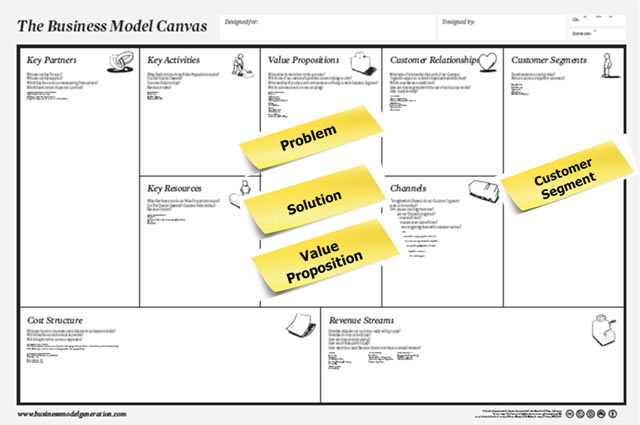Osterwalder’s Business Model Canvas Doesn’t Work for Start-ups
As each team in my executive innovation graduate class presented its corporate entrepreneuring project, frustration mounted. The teams had worked carefully, and sometimes painfully, through IDEO’s classic human-centered design thinking process—clarifying the problem they were trying to solve (for example, working professionals who are not at home during the day to accept package deliveries), identifying the customers who have the problem (working professionals), and defining the value of solving the problem for those customers (never missing a package, preventing theft of unattended packages). Following the lean start-up approach, the teams had then identified solutions on which to base their proposed start-ups based on customer visits; in this case, the solution the team suggested was a web page where customers could reroute packages or identify alternate delivery points. As the teams presented their ideas, they showed how they had mapped their stories on business model canvases following Osterwalder and Pigneur’s model (Business Model Generation, Wiley, 2010). In spite of all the careful preparation, though, teams grew increasingly confused and frustrated as the presentations went on, confusing the problem with the value proposition and the value proposition with the solution as all of the stories converged into the same part of the canvas.

Osterwalder and Pigneur’s business model canvas
Curiously, though, my undergraduate entrepreneuring class, also using the lean start-up approach, was having no such problems. They happily created business model canvases laying out problem, solution, and value, and we had productive, engaged discussions about their value propositions. The difference? With this group I was using Ash Maurya’s lean canvas (Running Lean, 2012, O’Reilly).

Maurya’s lean canvas
The tool made the difference: both classes were looking at start-up ideas, and one tool was much better suited than the other to the particular demands of the start-up context. Osterwalder and Pigneur’s canvas provides a superb visual ontology of the sustaining business, but it is missing key elements in the design of a new entrepreneurial business. The core elements of a start-up business model—problem, solution, and value proposition—are all jammed into one box, to make room for other elements that are important for a sustaining business. In Maurya’s start-up canvas, each of these key elements has its own box.
Why is having separate boxes for problem, solution, and value proposition so important? The business model canvas is, as one lean start-up guide puts it, “a tool for brainstorming hypotheses” (Blank, Engel, and Hornthal, Lean LaunchPad Educators Guide, 2013, p. 25). Having separate boxes for those central elements allows hypotheses to be formulated and tested around each element independently. Many start-ups fail not because of a fatal flaw in the innovation, but because the team fails to understand the problem it is solving. Having separate boxes for the problem, value proposition, and solution is critical to avoiding this mistake.
Osterwalder recognized this problem and addressed it by introducing the value proposition canvas (http://businessmodelalchemist.com/blog/2012/08/achieve-product-market-fit-with-our-brand-new-value-proposition-designer.html), which expands the value proposition and customer segment boxes of his original canvas into three sections: the solution/job to be done, the positive value of the solution (“gain creators”), and the negative value of the solution (“pain relievers”).
This helps solve the problem, but it means there are now two canvases that must be used in concert. Edward Tufte, a renowned scholar in the area of information design, offers a compelling discussion of the importance of presenting rich data illustrations in a single eye span—in other words, on one page—and the consequences of breaking that rule in Visual Explanations (Graphics Press, 1997); he argues convincingly that the 1986 explosion of the space shuttle Challenger, in which seven astronauts died, could have been predicted if the team making the launch decision had plotted all of the information it had on one descriptive illustration.
Maurya’s canvas avoids the problems of Osterwalder’s by focusing attention on the three core stories of the start-up journey. But it’s not detailed enough in other areas to be useful for large companies thinking about business models to support ideas at the front end of innovation (FEI).
Business model guru Mark Johnson (Seizing the White Space, Harvard Business Press, 2010) and I decided to develop a new canvas, one that bridges the gap between Osterwalder’s and Maurya’s models, offering a tool for large corporations seeking to define business models at the front end of innovation. Our design requirements for the new canvas were simple:
- It should contain all of the critical elements important to large corporations.
- It should be developed specifically for start-ups and the front end of innovation in corporations.
- Each item should be clearly independent of the other elements to enable teams to focus on one element at a time.
- Embrace the four box business model scaffolding (i.e. customer value proposition, profit formula, key resources and key processes advocated) by Mark Johnson.

FEI Canvas
The result was a canvas with seven boxes characterizing the critical elements of the start-up/front end of innovation landscape.
- Problem
- Solution
- Solution attributes (for example, attributes of a healthy food are low in calories and fat, high in fiber and protein)
- Competition and barriers
- Payment structure
- Key processes (infrastructure processes that provide competitive advantage)
- Risks and assumptions
So which canvas should you use? Osterwalder’s canvas is ideal for business model innovation in the sustaining business, to grow the market, increase sales, or expand the margins of an existing business. For entrepreneurial start-ups, Mauyra’s lean canvas should be the guiding tool. The FEI canvas should be used for discovery in large corporations.

No Comments